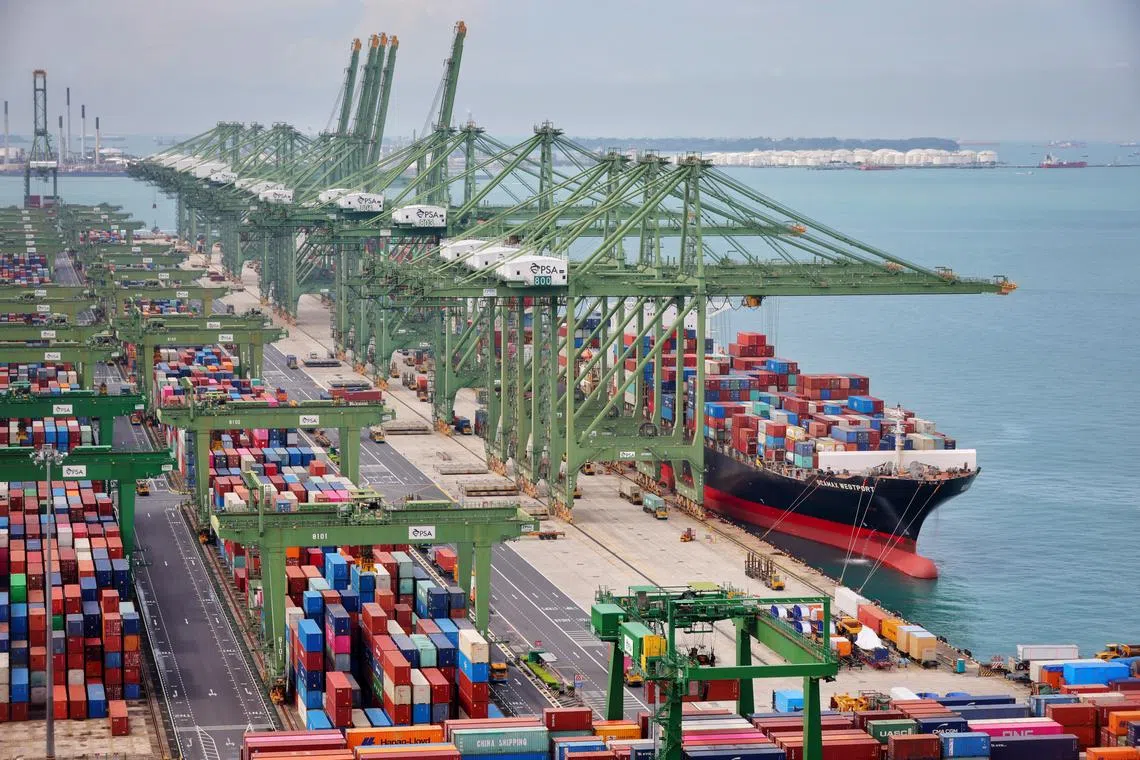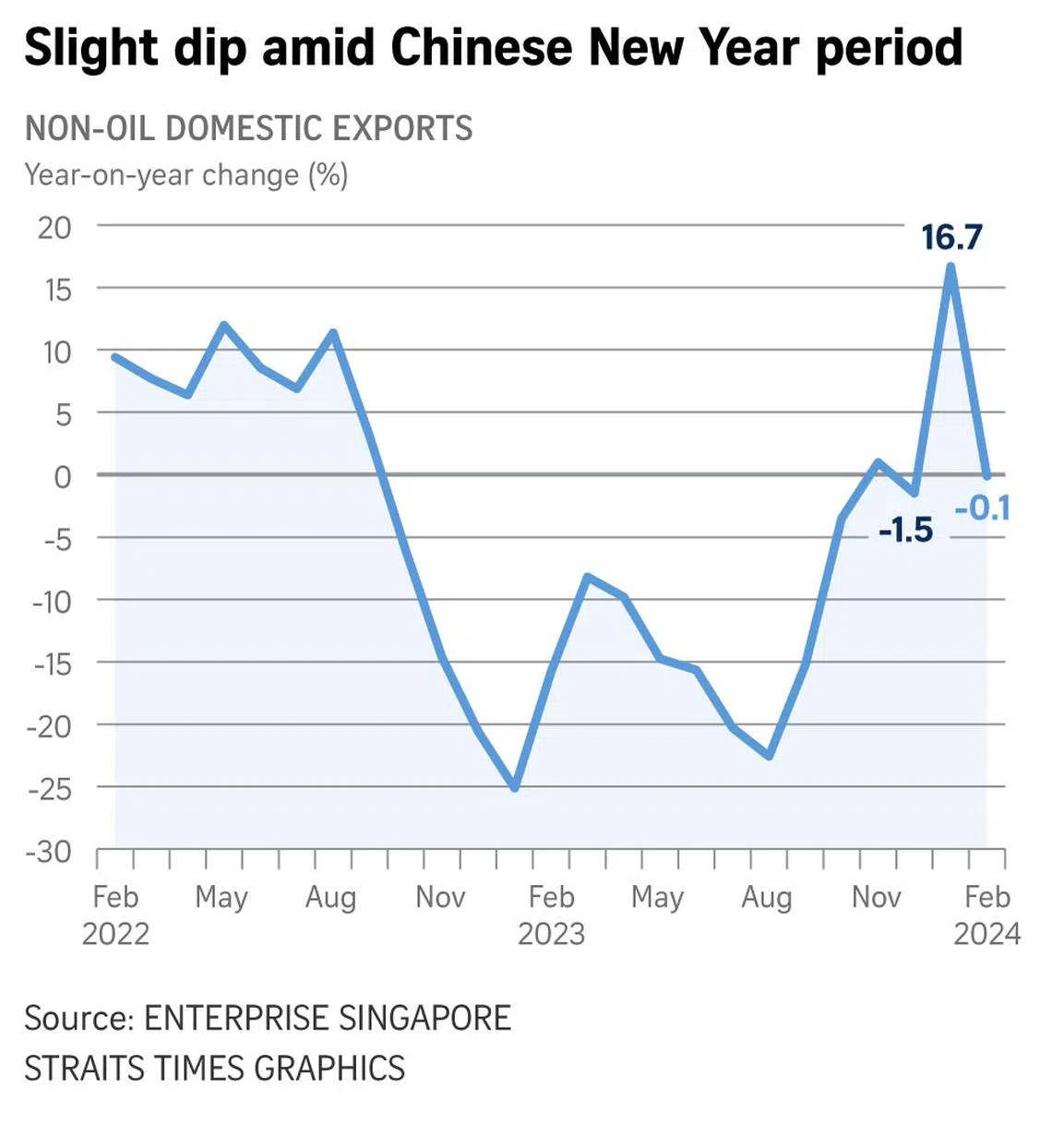Singapore’s key exports posted a surprise 0.1% slip in February, but economists stay optimistic
Sign up now: Get ST's newsletters delivered to your inbox

Economists pointed out that the February data was affected by the Chinese New Year period, which typically sees a reduced workforce and delays in the shipment of goods.
ST PHOTO: JASON QUAH
Follow topic:
SINGAPORE – Singapore’s non-oil domestic exports (Nodx) slipped 0.1 per cent year on year in February to $12.99 billion, but most economists remained optimistic about the economy, given a notable improvement in key electronics exports.
They also pointed out that the February data was affected by Chinese New Year, a period which typically sees many workers taking time off, leading to a reduced workforce and potential delays in the production and shipment of goods.
Still, the surprise dip was in stark contrast to Bloomberg’s consensus of a 4.7 per cent growth for February, and came after a 16.7 per cent year-on-year expansion in January.
Trade agency Enterprise Singapore (EnterpriseSG) also cited the impact of the Chinese New Year period in its release of Nodx data on March 18. It said that February’s figure was dragged by non-electronics products even as electronics exports rose.
However, for the first two months of 2024 combined, Nodx grew 8.4 per cent year on year.
This was an improvement from the 20.4 per cent year-on-year contraction registered for the same period in 2023, noted Ms Selena Ling, chief economist and head of global markets research and strategy at OCBC Bank.
Mr Brian Lee, an economist at Maybank, reckoned that base effects played a part in February’s Nodx decline, given that Chinese New Year in 2023 was earlier, in January.
“Overall, we think the export recovery remains intact, although the February figure was slightly weaker than anticipated. The Red Sea crisis may have impacted exports in the early months of 2024, disrupting supply chains and delaying shipments,” Mr Lee said.
The upcoming February manufacturing data scheduled to be released on March 26 will shed more light on the strength and momentum of the recovery, he added.
His optimism was underpinned by a notable acceleration in electronics Nodx growth, led by chip shipments which expanded for the first time since July 2022.
EnterpriseSG said electronics exports rose by 5.2 per cent in February compared with a year ago, following the 0.6 per cent increase in January.
However, non-electronics exports fell 1.5 per cent year on year in February, after the 21.1 per cent expansion in January.
Food preparations exports were a main drag coming from a high base a year ago. Exports of speciality chemicals and electrical circuit apparatus also fell.
On a seasonally adjusted month-on-month basis, Nodx declined by 4.8 per cent in February to $14.2 billion, compared with $14.9 billion in January.
Nodx to Singapore’s top markets as a whole rose in February, led by Hong Kong, the United States and Indonesia. Shipments to Japan, Malaysia, Taiwan, the European Union, Thailand, South Korea and China declined.
Nodx to Hong Kong climbed by 143.6 per cent in February, following the 60.8 per cent rise in January due to higher demand for integrated circuits, non-electric engines and motors, as well as specialised machinery.

Meanwhile, Nodx to the US grew by 17.1 per cent in February, a slower pace than in January, underpinned by pharmaceuticals, miscellaneous manufactured articles and personal computers.
As for Nodx to Indonesia, it was driven by a surge in non-monetary gold, petrochemicals and iron or steel scrap. Unlike monetary gold exchanged among central banks worldwide, non-monetary gold refers to all other types of gold in circulation, such as ingots, bars or powder.
Nodx to China fell slightly year on year in February, after doubling in January. But EnterpriseSG noted that based on combined figures to smooth out the impact of the Chinese New Year holiday, Nodx to China grew 44.5 per cent in combined figures for January and February, compared to the same period a year ago.
Overall, total trade grew 3.5 per cent in February, down from the 14.1 per cent growth the previous month. Total exports rose 1.7 per cent in February, while total imports were up by 5.6 per cent.
Looking ahead, Ms Ling is expecting the March Nodx to contract 8 per cent year on year due to the high base in March 2023. This will take the first-quarter 2024 Nodx to 2.9 per cent higher year on year. Ms Ling’s full-year 2024 Nodx forecast remains at 4 per cent to 6 per cent growth year on year.
“While the external demand picture is stabilising, the geopolitical implications on supply chain recalibration continue to shift,” she said.
“The implications for the rest of Asean manufacturing outlook, particularly for the chip sector, remains slightly cloudy at this juncture, although artificial intelligence-enabled phones and personal computers may see increased demand going forward,” she added.
Mr Chua Han Teng, an economist at DBS Bank, said the ongoing turnaround in Singapore’s electronics Nodx was an encouraging sign. He expects electronics shipments to benefit from the gradual improvements in global semiconductor sales as demand and inventory normalise.
However, export recovery will be gradual and fragile this year, with greater near-term volatility as the economic environment remains cloudy, he said.
He attributed this to high interest rates in advanced economies, lingering risks in China and ongoing geopolitical tensions that could still disrupt supply chains.


